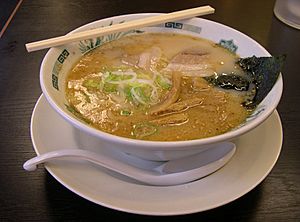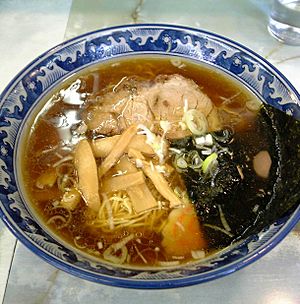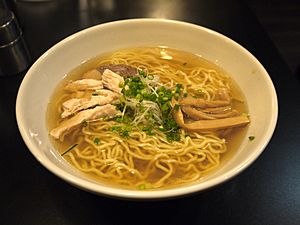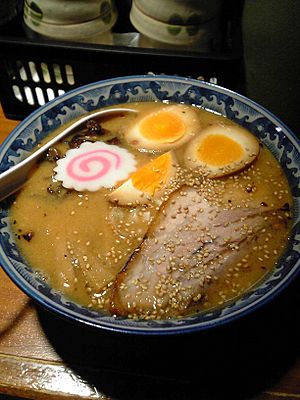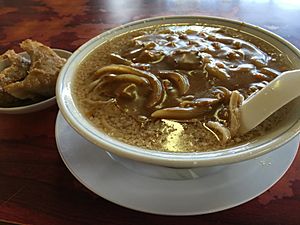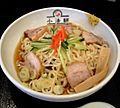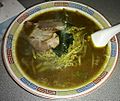Ramen facts for kids
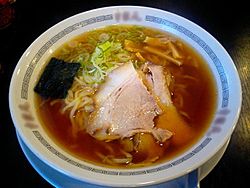
Shōyu (soy-based broth) ramen
|
|
| Alternative names | shina soba, chūka soba |
|---|---|
| Type | Noodle soup |
| Place of origin | Japan |
| Region or state | Yokohama Chinatown |
| Serving temperature | Hot |
| Main ingredients | Chinese wheat noodles, meat- or fish-based broth, vegetables or meat |
| Variations | Many variants, especially regional, with various ingredients and toppings |
Ramen is a delicious Japanese noodle soup. It's made with wheat noodles. Even though ramen is a big part of Japanese food today, it actually came from China a long time ago. Ramen is super popular in Japan, and you can find many shops selling it. People in Japan also love "instant ramen" because it's quick and easy to make at home. Now, people all over the world enjoy ramen too!
Ramen noodles come in many different shapes and sizes. They can be thin or thick, and either straight or curly.
In Japan, each area has its own special ramen, called "gotouchi ramen." For example, Hakata ramen is famous for its rich pork soup. Its noodles are very thin and cook super fast. Sapporo ramen is known for its tasty miso soup. Kitakata ramen is famous for its Shoyu (soy sauce) soup. Another popular flavor is Shio (salty) ramen. Lately, Gyokai-tonkotsu ramen, which mixes seafood and pork broth, is also a big hit.
Contents
History of Ramen
Where Did Ramen Come From?
Ramen is a Japanese version of Chinese wheat noodles. One story says that ramen first came to Japan in the 1660s. A Chinese scholar named Zhu Shunsui supposedly brought it. He was an advisor to Tokugawa Mitsukuni, a powerful Japanese leader. However, most historians think this story is just a myth.
A more likely idea is that Chinese people who moved to Japan brought ramen with them. This happened in the late 1800s or early 1900s, especially in Yokohama Chinatown. The Yokohama Ramen Museum says ramen started in China. It arrived in Japan in 1859. The first ramen dishes were wheat noodles in broth with Chinese-style roast pork on top.
What Does "Ramen" Mean?
The word ramen comes from the Chinese word lamian (拉麵). This means "pulled noodles." In 1910, the first ramen shop opened in Asakusa, Tokyo. It was called RAIRAIKEN. The Japanese owner hired 12 cooks from Yokohama's Chinatown. They made ramen special for Japanese customers.
Until the 1950s, ramen was often called shina soba. This means "Chinese soba." But today, chūka soba (中華そば), also meaning "Chinese soba," or just ramen (ラーメン) are more common. This is because the word "支那" (shina) became a bit rude.
Ramen's Early Days
By 1900, Chinese restaurants in Japan were serving a simple ramen dish. It had noodles, a few toppings, and a broth flavored with salt and pork bones. Many Chinese people in Japan also sold ramen from portable food stalls. They sold ramen and gyōza dumplings to workers.
By the mid-1900s, these stalls used a musical horn called a charumera to let people know they were there. Some sellers still do this today with a loudspeaker. By the early Shōwa period (around the 1920s), ramen became a popular meal when eating out.
A ramen expert named Hiroshi Osaki says the first shop just for ramen opened in Yokohama in 1910.
Ramen Becomes Super Popular
After World War II, Japan faced food shortages. The US sent a lot of cheap wheat flour to help. People started eating more bread, and wheat also found its way into ramen. Many Japanese people ate ramen from street vendors to get enough food.
Even though selling food outdoors was banned, flour was secretly sold on the black market. Thousands of ramen sellers were arrested during this time. Many Japanese soldiers came back from China after the war. Some of them already knew about wheat noodles.
By 1950, rules on wheat flour and food selling became looser. This made even more ramen vendors appear. Companies even rented out yatai (food cart) starter kits. These kits had noodles, toppings, bowls, and chopsticks. Ramen yatai gave people a chance to start small businesses after the war. All these things helped wheat noodles become very important in Japan's food culture, which used to be mostly about rice. Ramen slowly became a symbol of city life.
Ramen Today
In 1958, Momofuku Ando invented instant noodles. He was the founder of Nissin Foods. Instant ramen was voted the greatest Japanese invention of the 20th century. It let anyone make ramen just by adding boiling water.
Starting in the 1980s, ramen became a huge part of Japanese culture. People all over the world began to study it. At the same time, different types of ramen from various regions became famous across Japan. You could even order ramen by its regional name. A ramen museum opened in Yokohama in 1994.
Today, ramen is one of Japan's most loved foods. Tokyo alone has about 5,000 ramen shops! There are over 24,000 ramen shops across Japan. In December 2015, a ramen restaurant in Tokyo called Tsuta even received a Michelin star.
Types of Ramen
There are many kinds of ramen in Japan. Even ramen with the same name can be different depending on where you are or which shop you visit. Ramen is mostly known by its two main parts: the noodles and the soup.
Ramen Noodles
Most ramen noodles are made from four simple things: wheat flour, salt, water, and kansui (かん水). Kansui is a special kind of alkaline mineral water. It has things like sodium carbonate and potassium carbonate. Even though ramen noodles and Udon noodles both use wheat, they are different.
Kansui is what makes ramen noodles special. It first came from Inner Mongolia. Lakes there had lots of these minerals, and their water was perfect for making noodles. Using kansui makes the noodles a bit yellowish and gives them a firm, chewy texture. Sometimes, eggs are used instead of kansui. Some noodles are made without either eggs or kansui. These are usually for yakisoba because they are softer and soak up liquid easily in soup.
Ramen noodles come in many shapes and sizes. They can be thick, thin, or even flat like ribbons. They can also be straight or curly.
In the past, ramen noodles were made by hand. But as ramen became more popular, many restaurants wanted to make fresh noodles themselves. This helps them meet demand and make sure the noodles are good quality. Machines that make ramen noodles like they are made by hand have been around since the mid-1900s.
Ramen Soup
Ramen soup usually starts with a broth made from chicken or pork. Then, many other ingredients are added. These can include kombu (seaweed), katsuobushi (skipjack tuna flakes), niboshi (dried baby sardines), beef bones, pork bones, shiitake mushrooms, and onions. Some modern ramen broths are even made from vegetables only.
Ramen Flavors
Ramen soups are usually put into four main groups, based on their flavor. But new and unique kinds of ramen often mix these up! Here are the main types, from oldest to newest:
- Tonkotsu (豚骨, "pork bone") soup is usually cloudy and white. It's like a Chinese baitang soup. This thick broth is made by boiling pork bones, fat, and collagen for many hours. This gives the soup a rich pork taste and a creamy texture, almost like milk or gravy.
- Shōyu (醤油, "soy sauce") ramen has a clear brown broth. It's made from chicken and vegetable (or sometimes fish or beef) stock. Lots of soy sauce is added, making the soup tangy, salty, and savory, but still light. Shōyu ramen often has curly noodles, but not always. It's usually topped with marinated bamboo shoots (menma), green onions, carrots, fish cakes (kamaboko), seaweed (nori), boiled eggs, or bean sprouts. Sometimes, chili oil or Chinese spices are added. Some shops even use sliced beef instead of the usual chāshū (barbecued pork).
- Shio (塩, "salt") ramen is the oldest type of ramen. It has a pale, clear, yellowish broth. It's made with lots of salt and a mix of chicken, vegetables, fish, and seaweed. Sometimes pork bones are used, but they are not boiled as long as for tonkotsu ramen. This keeps the soup light and clear. Chāshū is sometimes swapped for lean chicken meatballs. Pickled plums and kamaboko (a slice of fish roll, often with a pink spiral called narutomaki) are also popular toppings. The noodles for shio ramen can be different, but they are usually straight.
- Miso (味噌) ramen is a newer type, becoming popular around 1965. This special Japanese ramen started in Hokkaidō. Its broth mixes a lot of miso (fermented soybean paste) with oily chicken or fish broth. Sometimes tonkotsu or lard is added. This creates a thick, nutty, slightly sweet, and very hearty soup. Miso ramen has a strong, tangy flavor. So, it goes well with many tasty toppings. Spicy bean paste (tōbanjan), butter and corn, leeks, onions, bean sprouts, ground pork, cabbage, sesame seeds, white pepper, and chopped garlic are common. The noodles are usually thick, curly, and a bit chewy.
- Karē (カレー, "curry") ramen is ramen cooked with curry soup. It's thought to have appeared in Japan more recently. Several cities in Japan claim to be where it started. Muroran city says it began there in 1965. Sanjō city says it started over 80 years ago. Katori city also claims it. Curry soup is mainly made with pork bones and vegetables. It's seasoned with curry. The noodles are thick and curly. Toppings include chāshū, wakame, and bean sprouts.
Ramen Toppings
After the basic ramen is made, you can add many different toppings to make it even better! Here are some common ones:
- Chāshū (sliced barbecued or braised pork)
- Negi (green onion)
- Takana-zuke (pickled and seasoned mustard leaves)
- Seasoned (often salted) boiled egg
- Bean sprouts or other sprouts
- Menma (bamboo shoots that have been fermented)
- Kakuni (braised pork cubes)
- Nori (dried seaweed)
- Kamaboko (formed fish paste, often a pink and white spiral called narutomaki)
- Corn
- Butter
- Wakame (a type of seaweed)
- Olive Oil
Images for kids
See also
 In Spanish: Ramen para niños
In Spanish: Ramen para niños



